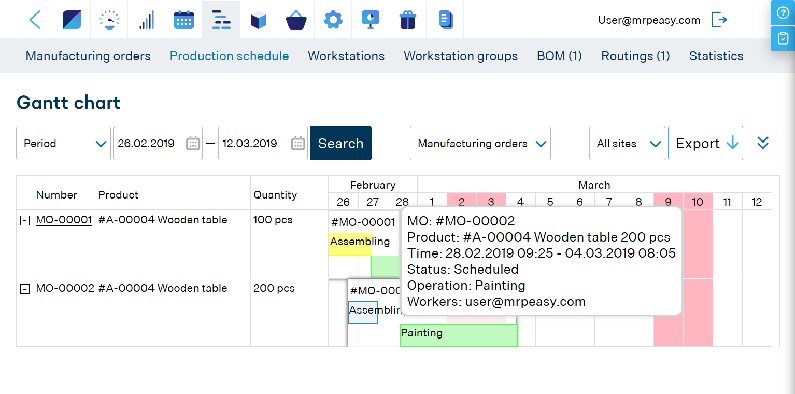How to Manage Supply Chain Disruptions?
The world has experienced historic supply chain disruptions during the last years. From trade wars and COVID-19 to semiconductor shortages and the Suez canal blockage – there are few industries that have not been affected. The lesson learned is to be better prepared and to remain flexible.

You can also listen to this article:
Traditionally, manufacturing companies lived by their supply chain. If the chain was well-managed, companies could realize greater profits. If not, they experienced higher costs and loss of competitiveness. To address this, supply chain professionals created complex models for managing supply chains that relied heavily on lean methodology and JIT (Just-In-Time) planning. The entire global supply chain system became attuned to the lowest cost and most optimized volumes delivered at or near the point of use.
However, the last few years have thrown the entire global supply chain into chaos. Beginning with the tariff and trade wars, political uncertainty, and other events: disruption began to impact the global supply chain in unprecedented ways. This was followed by the seismic upheaval of 2020’s worldwide pandemic, followed by 2021’s “stuck in the canal” cargo debacle. Suddenly, weaknesses in an assumed smooth and stable global supply chain were exposed.
Traditional supply chain weaknesses
The re-evaluation of global supply chain management for most companies wasn’t because there was a disruption. Supply chain disruptions have always been present, and most companies had at least minimal contingency programs to address them. But in the last half-decade, it was the number and scale of disruptions that have exposed weaknesses in supply chain planning and caused many companies to rethink their strategy. The result is a newly emerging – and still evolving – supply chain model based on the assumption that regular disruption centered on large-scale events is here to stay rather than one that assumes an ever stable chain.
Fully 76% of manufacturers feel that these weaknesses were exposed by the pandemic alone. Because of this and other significant events, the same proportion of companies are planning to ask for changes from vendors to mitigate future problems as they occur. Steps include greater diversification of supplier base (45%), consolidation or evaluation of existing suppliers (16%), and logistics evaluation to address late delivery and other lead time issues.
As manufacturers struggle to find the right combination of strategies to improve supply chain models, here are a few of the weaknesses they are addressing:
1. Focusing on cost
For the last two decades, supply chain management had become predominantly cost-driven. Purchasing strategies were designed to identify the lowest cost supplier regardless of where they were on the globe. Far-flung supply chains were standard, with companies sourcing many raw materials from China and other parts of Asia. This cost-focused strategy was shown to be a weakness during COVID-19 as the distance was compounded by countries battling the pandemic, much like manufacturers in Western countries. With cost as the only factor, many companies had few or no backup vendors.
2. Relying on the lean methodology
As supply chains were considered inherently stable, many professionals and managers began to use lean methodology to manage the supply chain. But while lean has been crucial to increasing efficiency and eliminating waste in manufacturing, it has proven to be less effective in a disruption-prone global economy. Demand, capacity, labor, inventory, and many other areas working on lean principal have been impacted during disruption, leaving manufacturers struggling to cope.
3. Linear statistical analysis
Traditional supply chain methods were also statistically linear in many companies. While many had adopted MRP and demand planning software to help manage operations, there was still a lot of spreadsheet-based planning and scheduling that relied on slow and error-prone human analysis. Because of this, transactional data was often pushed from one department to the next in order. The thought of the chain being dynamic and a “two-way street” where data was shared was not expected.
4. Data fragmentation
Perhaps few issues showed the inherent weakness of traditional supply chain models other than fragmented data. Because many companies still lagged in digital transformation and maintained either manual or disparate software systems with little interoperability, data was still siloed and not available or understandable to everyone within the chain. This held back sophisticated analytics from being deployed to understand how each segment of the chain relied upon one another. And the fact that it was one-way kept companies from deploying automated solutions in a dynamic system.
Impact of disruption on supply chains
As these weaknesses became apparent, there was a severe impact on each supply chain segment as each new disruption hit. These impacts include:
Supplier instability
Supply chain disruptions of the last few years have tended to be global rather than regional. Because of this, manufacturers encountered supplier instability unlike any experienced before while suppliers were dealing with the same disruption. It was no longer an issue of finding expedited or rerouted shipping; it was instead a hard stop. Long-term relationships were turned upside down. Many producers wound up with no backup vendors, causing either a scramble for the available stock from other sources or even shut down in some manufacturing segments.
Raw material cost
Manufacturers have always looked to control raw material costs. But in recent years, the impact was not simply a decimal point margin issue between low and next to lowest price. In many cases, it became an issue of no availability versus availability at a cost that proved prohibitive to production, causing many companies to temporarily shutter operations rather than make goods at a price higher than consumers were willing to spend.
Production costs
Supply chain disruptions also impact production costs. Both direct and indirect costs have increased in recent years as companies struggled with stock-outs, remote working sales, customer service staff, and COVID-19 related shutdowns and mitigation procedures.
Cash flow
Many companies experienced cash flow issues related to the new disruptions. Because the assumption of a stable supply chain meant long-term contracts at high volume over an extended delivery period, companies found that cash needed to pivot production to more profitable products was tied up in goods that would take much longer to arrive.
Steps for managing supply chain disruptions
To mitigate the effects of disruption within supply chains, manufacturers must deploy new strategies. And any of the components of these strategies are opposite from the assumptions of the last twenty years. This means making choices and tradeoffs to optimize production operations to the most profitable products. It also means planning for broader swings in demand and implementing them on the production floor quickly.
To accomplish this. Companies will need to automate as much as possible to leverage production data to move away from a lean-oriented supply chain to agile and resilient. MRP, demand planning software, and S&OP processes can help break down silos and inject end-to-end visibility of the supply chain and its impact on production. By using these tools, manufacturing companies can create two-way, transparent, dynamic supply chains that work with MRP and ERP software to adjust quickly.
Steps to manage supply chain disruption include:
1. Manage known risks
While no one can predict all threats, it is possible to map and assess areas of the supply chain where these threats occur. These trouble spots can be included in supply chain management practices and taken in detail down to the production floor level. Knowing how to respond in a crisis can save profit and help hold down high production costs during disruption.
2. Rethink inventory optimization
Supply chain inventory optimization has become almost synonymous with lean thinking. However, it has become clear that additional safety stock may be necessary. Inventory optimization strategies can also include the regionalization of suppliers through multiple vendors rather than reliance upon one low-cost supplier.
3. Reconsider supplier distance
Many manufacturing companies are considering the distance between their production facilities and their suppliers. Many manufacturing companies have begun reshoring suppliers by moving to local or regional sources despite the higher cost. Another effective strategy is nearshoring, where raw materials purchased in China or Asia are brought closer to production, such as Mexico for the US.
4. Manage demand
Managing demand is easier today than before. Demand planning software that is interoperable with MRP and ERP systems can help sense and detect demand trends and help deploy automated solutions to adjust supply orders up or down as needed.
5. Enable agile scheduling
Software can also help in creating more agile and dynamic scheduling. MRP systems today have dynamic BOMs, shop floor functionality, job planning, capacity planning, and more. Analytics and accurate software data can help manufacturers develop “what-if” scenarios to plan for contingencies should they be required.
Using data to manage supply chain disruptions
While disruption is here to stay in some form or another, manufacturing companies have tools available to reduce the impact and plan ahead. Companies must realize that human analysis, spreadsheets, and verbal agreements will no longer work in today’s supply chain environment or manufacturing world. Instead, robust, cloud-based manufacturing software can help optimize processes at the factory level with advanced ERP and MRP platforms, while demand and supply planning software can help manage the supply chain. Developing prudent and well-considered steps to create new supply chain strategies, combined with leveraging data through the use of best-in-class software, can help any manufacturer navigate disruption and continue to succeed.
Key takeaways
- Until today, supply chain management has evolved to achieve minimal costs and optimized volumes.
- The last few years have brought massive disruptions into supply chains as well as to the reigning supply chain management paradigm.
- The latest large disruptions have revealed weaknesses in manufacturing and distributing supply chains such as over-focusing on cost, relying entirely on just-in-time deliveries and linear analysis methods, as well as using fragmented data.
- These weaknesses allowed the latest global disruptions to have a massive effect on the supplier stability, raw material and production costs, and cash flow of many companies.
- Although many supply chain disruptions are very difficult to predict, it is always possible to prepare for them. Steps for doing so include: managing known risks, reassessing inventory optimization, reconsidering supplier distance, managing demand, and using better scheduling practices.
- An ERP/MRP system is a great tool for basic management of your supply chain and staying flexible during disruptions.
You may also like: Procurement Management – A Quick Guide for Small Manufacturers



